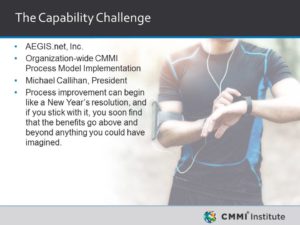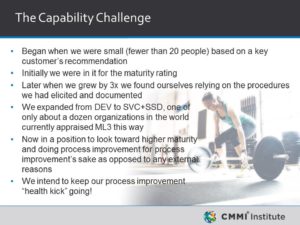 This is a version of the story I told in January 2016 for the CMMI Institute’s Capability Challenge webinar series and again at the finals in Annapolis on May 9, 2016. The following day, May 10, AEGIS was awarded the inaugural Capability Challenge Championship. I hope you enjoy the story….
This is a version of the story I told in January 2016 for the CMMI Institute’s Capability Challenge webinar series and again at the finals in Annapolis on May 9, 2016. The following day, May 10, AEGIS was awarded the inaugural Capability Challenge Championship. I hope you enjoy the story….
Our process improvement journey has been like a person who goes on a health kick and only after sticking with it for a while finds the true benefits, which can be quite significant.
There are a number of parallels between organizational process improvement and personal health improvement. A health kick often begins with a particular stimulus: your doctor tells you to shape up, or maybe your spouse or kids say something, or maybe “today is the day” when you look down at that bathroom scale. Back in January when I first gave the pitch, it was, of course, during the time of year when folks often make a new year’s resolution.
In our case, our organizational push came from a government customer who strongly encouraged us to look in to the CMMI. We could see that future procurements depending on us demonstrating credibility against some large, established players. We realized a CMMI maturity rating could help us attain such credibility. Of course, I had a somewhat selfish interest in seeing AEGIS implement CMMI since, as I like to say, both the CMMI and I are graduates of Carnegie Mellon!
Another parallel is that when you’re trying to get healthier, it helps to have a great personal trainer. I think it’s intuitive that a trainer improves your chance of success with your health kick – success being defined as a more or less permanent lifestyle change resulting in continuous improvement. When it comes to CMMI implementation, the role of trainer is played by the SCAMPI Lead Appraiser. We worked with and continue to work with Dr. Richard Bechtold of Abridge Technology who did a fantastic job helping us first develop a strong self-image in taking credit for what we were already doing well. He then pushed us to do better – find gaps with respect to our implementation of the model and fill them.
In doing so, we chose to take a lean approach keeping our procedures brief and not overly prescriptive. Given that we need to be able to adapt specifics of our approach to align with unique needs or requirements of particular clients, we wanted to clearly set the stage — but not write a script. For example, in software development efforts, we need to be able to accommodate both traditional software development methods like waterfall and modern ones like the various forms of Agile development, because different clients have different approaches they want our teams to follow. Likewise, the kind of work involved in IV&V is different from the kind of work involved in development – our procedures need to consider that. If they are too granular, we saw we could get ourselves into trouble, but if they were too general they wouldn’t be terribly helpful.
Dr. Bechtold helped us understand that part of the lifestyle change we had to go through was to realize we were not going to get it perfectly right the first time, or even the second or third time. We were going to put a stake in the ground, see how it goes, and then work as necessary to improve over time. That can be one of the hardest aspects of process improvement especially getting everyone in the organization to buy in to that mindset. It has to come from the top. So I myself and the rest of our executive team rolled up our sleeves and showed we were committed to this idea.
Something else we did at AEGIS that I think is somewhat unconventional is that as a leadership team, we decided and clearly conveyed that we were not putting the organization on a clock to become level X by date Y. Part of the reason was that we had folks on board who had been through death marches to CMMI at other companies and had counseled us that it was a really bad experience – so we listened to them.
Another reason, though, was that we wanted to make sure our process improvement efforts took root and we felt that arbitrarily establishing a timeline for a series of activities none of us could fully scope was probably not conducive to that goal. We felt we would end up rushing and cramming and not truly institutionalizing.
Of course, that was our sense for our organization – other organizations might need different motivation.
The other point to make here is that while leaders have to lead, the real work needs to get done by all the people in the organization. AEGIS is blessed with some of the best IT practitioners and support staff in the business, I really believe that. And they are the ones who have made and continue to make our process improvement effort so successful.
AEGIS is blessed with some of the best IT practitioners and support staff in the business, I really believe that. And they are the ones who have made and continue to make our process improvement effort so successful.
Back to our journey, we tested our capability maturity strength at key points to gauge our fitness. We did this with a Class C and a Class B appraisal. We made some adjustments and then proceeded with the SCAMPI-A. As a result of our preparation, we went into that Class A with a lot of confidence. And of course, it went very well.
Since then, we have gone on to be appraised two more times, most recently this past October. We added the Services constellation in 2012 including Service Systems Development because it’s so relevant to the kind of work we do.
What has been surprising is the way the model has helped us when we didn’t expect it. After our initial implementation work and first appraisal, our company grew to roughly triple in size. What we noticed is how much we relied on our processes during that growth in terms of things like on-boarding new folks and orienting people to particular projects.
Having the processes in place made it relatively easy for us to show new people the AEGIS way and ensure consistent performance even from people who were just joining the organization.
We’re now positioned to consider going to the next level. Having operated at level 3 for several years, we have some good ideas for the metrics that would be meaningful for us to track and focus on for advancement to higher maturity. Again, it relates to the health kick.
Once you get in shape, you start to identify a lot of metrics that help focus your continued training based on the goals you’d like to achieve. Maybe it’s a lower resting heart rate, maybe it’s bumping up the intensity level a notch on the treadmill or stationary bike and being able to sustain that for 30 minutes, or maybe it’s striving for another 10 pounds on the bench press.
The point is: the metrics you track and the goals you set are unique to you. The same goes for an organization on a process improvement journey. That’s where we’re at organizationally – feeling good, seeing the benefits, and now interested in where to focus improvement to get to the next level.

